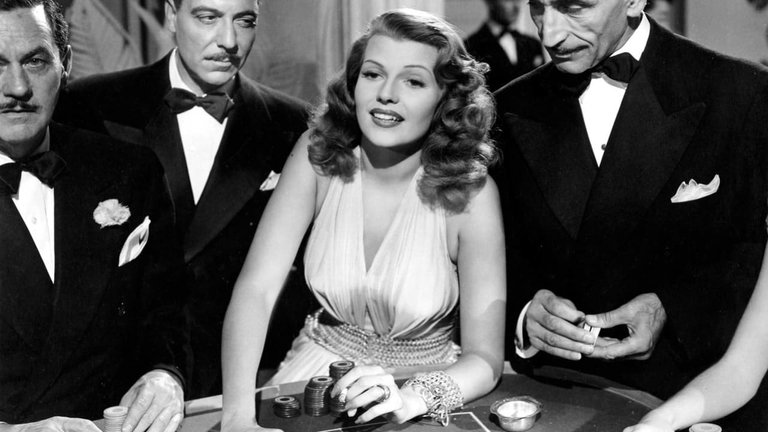Film Review: Gilda (1946)

In today’s Hollywood stars (or what goes for stars these days) are made by appearing in the big films. In the golden age of Hollywood films became big by having big stars. One of the most telling example is Gilda, 1946 crime drama directed by Charles Vidor, best known for Rita Hayworth delivering one of the most legendary performances in history of cinema.
The plot is set in Buenos Aires near the end of Second World War. Protagonist and narrator is Johnny Farrel (played by Glenn Ford), American adventurer who tries to make ends meet by playing craps with loaded dice. That gets him in trouble from which he gets rescued by Ballin Mundson (played by George Macready), owner of luxurious and illegal casino who likes Johnny so much that, after catching him cheating in his own casino, actually employs him as manager. Johnny is surprised with this, but even more surprised to find that his boss has married Gilda (played by Rita Hayworth), beautiful lounge singer and Johnny’s former girlfriend. Relationship has ended badly, making former lovers resent each other. While Gilda openly flirts with other men, Ballin, unaware of Johnny’s past, gives him the task to watch over her. Situation is further complicated with Ballin’s ambitious plans to build global business empire based on tungsten monopoly, which involves shady businessmen from Germany.
There were few stars that could elevate a single film in a manner Rita Hayworth did with Gilda. By the time of production she was already star, being established in light hearted musicals and comedies and, more importantly, having her popularity enhanced with famous 1941 photo featuring her in black lace nightgown and which made her the most popular pin up girl for US servicemen in Second World War. Role of Gilda was the first major foray into the more serious dramatic roles and it was the test Hayworth passed with flying colours. In Gilda her acting her good, although the audience paid much more attention to her stunning looks that made her character into one of the most iconic femme fatales of 1940s Hollywood. Helped by excellent black-and-white cinematography by veteran Rudolph Maté and innovative costumes by Jean Louis, she lights up the screen with sensuality and provides some of the most erotic moments that notoriously puritan Hollywood censorship of its time would allow. Those include her introductory scene when she flips her hair and famous “Put the Blame on Mame” song number during which she seductively removes her glove. Hayworth’s Gilda represents proverbial woman men want and women want to be. Her performance is also helped by great chemistry with Glenn Ford, an actor with whom she had romance on the set that would, with interruptions, continue for most of her life.
Hayworth instantly turned Gilda into major success and quickly earned reputation of “love goddess” or what some would later describe as “sex bomb”. The latter term was partially inspired by popular imagination connecting unrestrained feminine sexuality being connected with the irresistible power of nuclear weapons in post-WW2 years. This phenomenon was created by Operation Crossroads, famous nuclear weapons test on Bikini Atoll which, among other things, gave name to new and popular form of minimalist female swimsuit. The test was conducted shortly after premiere of Gilda and the bomb used in it was actually named “Gilda”, much to the displeasure of Rita Hayworth. The actress, known for her colourful private life, later began to resent her most famous role, describing how “men was falling in love with Gilda only to wake up with Rita Hayworth”.
Effect of Rita Hayworth becomes even more impressive after realisation that without her, 1946 film actually isn’t much to write home about. Columbia has invested a large budget, but direction of Charles Vidor, although solid, is uninspired. Buenos Aires setting, brought into the script in order to calm censors of Hays Office who were more prone to tolerate amoral “noirish” characters outside America, is almost unnoticeable in the film. While the acting is solid, especially in the case of Hungarian actor Steven Geray to plays comic relief in form of casino’s wash room attendant Uncle Pio, it can’t compensate for messy script that is often confusing and doesn’t bother explaining characters and their motives. Strange relations between Gilda, Johnny and Ballin was later by critics and film scholars explained as bizarre “ménage à trois” that includes bisexuality, an explanation that actually amused both Vidor and Ford. Subplot involving shady business dealings and Ballin’s dreams of world domination is also undeveloped and seems more like an afterthought and attempt to exploit public’s anxiety about the true state of post-WW2 world. As a result, viewers who expect to see great Hollywood icon delivering magic on screen will probably appreciate Gilda. Those who expect true film noir will not.
RATING: 6/10 (++)
_
Blog in Croatian https://draxblog.com
Blog in English https://draxreview.wordpress.com/
InLeo blog https://inleo.io/@drax.leo
InLeo: https://inleo.io/signup?referral=drax.leo
Stars Arena: https://www.starsarena.com/?ref=draxblog
Unstoppable Domains: https://unstoppabledomains.com/?ref=3fc23fc42c1b417
Hiveonboard: https://hiveonboard.com?ref=drax y
Bitcoin Lightning HIVE donations: https://v4v.app/v1/lnurlp/qrcode/drax
Rising Star game: https://www.risingstargame.com?referrer=drax
1Inch: https://1inch.exchange/#/r/0x83823d8CCB74F828148258BB4457642124b1328e
BTC donations: 1EWxiMiP6iiG9rger3NuUSd6HByaxQWafG
ETH donations: 0xB305F144323b99e6f8b1d66f5D7DE78B498C32A7
Posted using CineTV
https://reddit.com/r/cine/comments/17f18k7/film_review_gilda_1946/
The rewards earned on this comment will go directly to the people sharing the post on Reddit as long as they are registered with @poshtoken. Sign up at https://hiveposh.com.